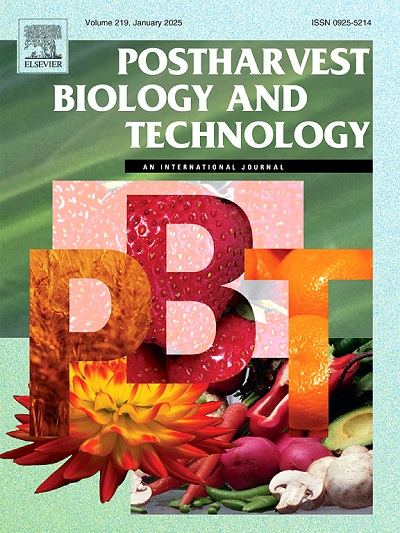Tolerance mechanism of pear to hypoxic storage: A transcriptome study
IF 6.4
1区 农林科学
Q1 AGRONOMY
引用次数: 0
Abstract
Postharvest pear (Pyrus communis L.) is often stored at low temperatures under an atmosphere with low O2 and high CO2 partial pressure (‘controlled atmosphere storage’, CA). While this condition helps to maintain fruit quality and prolong storage life, how the long-term hypoxia impacts the pear transcriptome is unknown. This study aimed to explore changes in the pear transcriptome associated with CA storage using RNA-sequencing. ‘Conference’ pears were stored for 6 months at either CA or regular air. Over 270 million paired-end reads were mapped onto the Pyrus communis ‘Bartlett’ DH Genome and differences between the expression profiles of CA-stored and regular air-stored fruits were assessed. Genes involved in energy status, redox state, secondary metabolism, and lipid biosynthesis were highly altered in hypoxic pears. Additionally, differentially expressed genes (DEG) related to cell senescence, apoptosis, autophagy, and plant hormone signaling were detected. This study is the first to highlight the potential involvement of crucial programmed cell death (PCD) factors, including vacuolar processing enzyme, metacaspase, and substilase, in CA-stored pear fruit. By integrating the pathways of these DEGs into a conceptual model, a coping mechanism for ‘Conference’ pear to long-term hypoxic-CA storage is proposed. These new markers might help to reveal the molecular causes of storage disorders triggered by low O2 conditions.
梨对低氧贮藏的耐受机制:转录组研究
采后的梨(Pyrus communis L.)通常在低O2和高CO2分压的气氛下低温储存(“可控气氛储存”,CA)。虽然这种条件有助于保持果实品质和延长贮藏寿命,但长期缺氧对梨转录组的影响尚不清楚。本研究旨在利用rna测序技术探索梨中与CA储存相关的转录组变化。“会议”梨在CA或常规空气中储存了6个月。超过2.7亿个对端reads被映射到Pyrus communis ' Bartlett ' DH基因组上,并评估了ca储存和常规空气储存果实的表达谱差异。参与能量状态、氧化还原状态、次生代谢和脂质生物合成的基因在缺氧梨中高度改变。此外,还检测到与细胞衰老、凋亡、自噬和植物激素信号传导相关的差异表达基因(DEG)。这项研究首次强调了钙储存梨果实中关键的程序性细胞死亡(PCD)因子的潜在参与,包括液泡加工酶、metacaspase和substilase。通过将这些deg的途径整合到一个概念模型中,提出了“会议”梨到长期低氧ca储存的应对机制。这些新的标记可能有助于揭示由低氧条件引发的储存障碍的分子原因。
本文章由计算机程序翻译,如有差异,请以英文原文为准。
求助全文
约1分钟内获得全文
求助全文
来源期刊

Postharvest Biology and Technology
农林科学-农艺学
CiteScore
12.00
自引率
11.40%
发文量
309
审稿时长
38 days
期刊介绍:
The journal is devoted exclusively to the publication of original papers, review articles and frontiers articles on biological and technological postharvest research. This includes the areas of postharvest storage, treatments and underpinning mechanisms, quality evaluation, packaging, handling and distribution of fresh horticultural crops including fruit, vegetables, flowers and nuts, but excluding grains, seeds and forages.
Papers reporting novel insights from fundamental and interdisciplinary research will be particularly encouraged. These disciplines include systems biology, bioinformatics, entomology, plant physiology, plant pathology, (bio)chemistry, engineering, modelling, and technologies for nondestructive testing.
Manuscripts on fresh food crops that will be further processed after postharvest storage, or on food processes beyond refrigeration, packaging and minimal processing will not be considered.
 求助内容:
求助内容: 应助结果提醒方式:
应助结果提醒方式:


